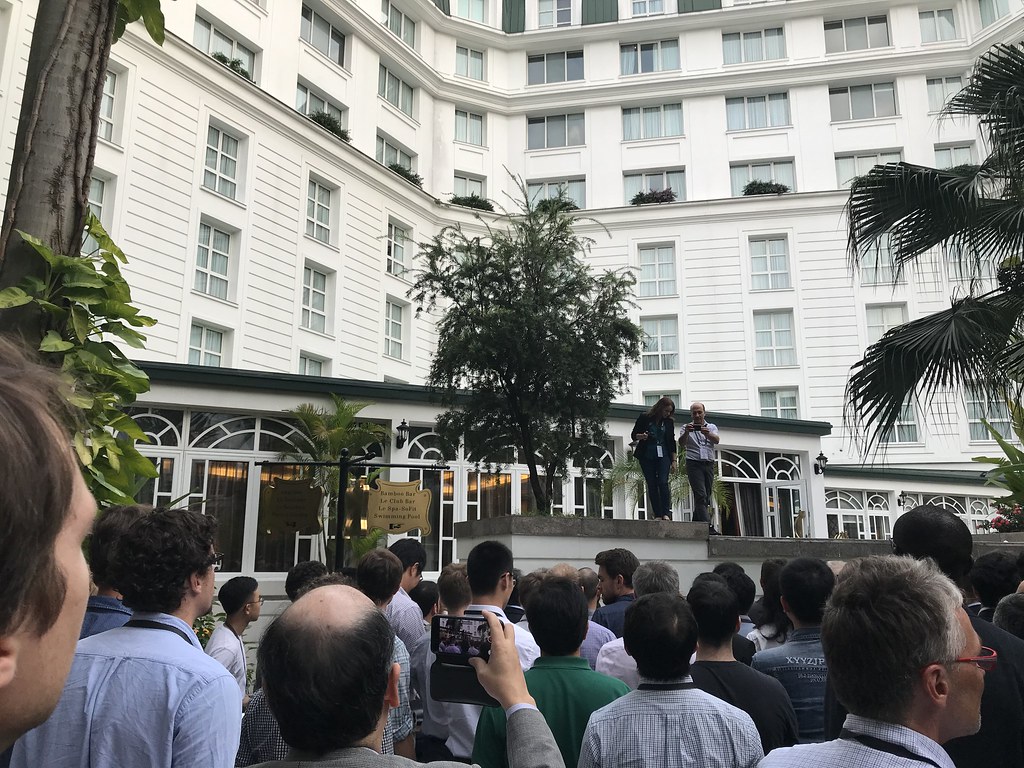International Symposium on Robotics Research (ISRR) 2019, Day 4 of 5

After the last batch of technical talks, the ISRR 2019 attendees gathered around in the Sofitel to take a group photo. It's now visible on the ISRR website!
The third full conference day was much easier on me, because I did not have to think about rehearsing my talk.
For today, I also did something I wish I had done earlier: taking pictures of students giving talks, and then emailing them the pictures. I sent all emails by the end of the day, and eventually heard back from all the recipients with appreciation. I hope they post them on their websites. I am not sure why I did not do this for all the student presenters, because this seems like an obviously easy way to “network” with them. I might be seeing these students in future conferences or employment settings.
The captioners struggled to understand some of the faculty speakers. They also told me two new issues: that there was an echo from the room, and that every time I type something into my iPad (e.g., when switching tabs) they hear it and it overrides the microphone’s sound. I am at a loss on why there was an echo in the room, and I was wondering why I did not know about the “iPad typing issues” beforehand. Once again, having some kind of checklist where I can go through common issues would be great.
Fortunately, the captioners were able to understand Peter Corke’s talk today, and his was among the most relevant to my research area. (Incidentally, Peter Corke was the chair for ICRA 2018 in Brisbane, which I wrote about in several blog posts here.) Hence, I enjoyed Corke’s talk; he contrasted the computer vision and robotics fields by describing the style of papers in each field, and proposed several “assertions” about how the robotics community can make more research progress, similar to how the computer vision community made substantial progress with ImageNet competitions.
Before the talks concluded, Oussama Khatib made a few announcements. He presented a few slides about the history of ISRR and the closely related conference on experimental robotics, ISER. He then made the grand reveal for where ISRR 2021 would be located. (Remember, this conference only happens once every two years.)
And … drum roll please: ISRR 2021 will be located in Zurich, Switzerland, from July 19 to 23! It will also be co-located with a few other robotics conferences at that time, along with a “Joint Robotics Congress” which I hope means we can talk with some policy makers from certain countries. I hope I can submit to, and attend, ISRR 2021!
We wrapped up the day with the farewell reception, which was a full dinner at the conference hotel (the Sofitel Legend Metropole). This was a fixed set menu of Vietnamese food, and included:
-
Crab soup, with the usual broth that’s standard in Vietnamese cuisine. Again, I suspect it is some kind of fish sauce.
-
Chicken salad with onions, sprouts, and herbs.
-
Fried prawns with passion fruit sauce and vegetable fried rice. These prawns were huge!
-
Sticky rice and lotus desserts.
-
Unlimited refills for beer and wine.
The seating situation was ideal for me, because I was sitting at a table in the corner, and only had one person, another student, next to me. A second person next to me would hypothetically increase the sound nearby by nearly a factor of two. The student was nice and I was able to communicate reasonably well. During the dinner, the captioners did a great job recording the conversations happening at my table. I applaud them for their performance that night. Discussions ranged from food in Vietnam, aspects of various robotics conferences, how to get in PhD programs, how to read research papers, details about Berkeley itself, and a bunch of other things I can’t remember.
After these great meals, I conclude that ISRR, though it may be a small conference, is leaving a strong impression for high quality food.